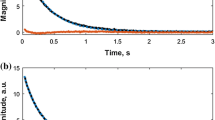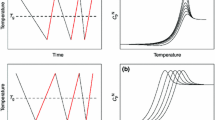Abstract
The feasibility of time-domain NMR curve-fitting methodology for the quantitative determination of TG blend phase compositions was investigated. By studying a range of TG in their different crystal forms, it was shown that the transverse NMR relaxation characteristics of TG differ for the respective crystal polymorphs {α,β,β′}. This enables the TG polymorphism in fat blends to be quantitatively determined by curve fitting. If a liquid phase is present in the blend, curve fitting is able to determine the solid fat content, and the results compare well with those of the accepted NMR methods. The curve-fit method is less hindered by some of the disadvantages of these accepted methods, such as the use of a calibration factor.
Similar content being viewed by others
References
Wesdorp, L.H., Multiple Solid Phase Equilibria in Fats—Theory and Experiments, Ph.D. Thesis, Delft Technical University, Delft, The Netherlands, 1990.
van Duynhoven, J.P.M., G.J.W. Goudappel, M.C.M. Gribnau, and V.K.S. Shukla, Solid Fat Content Determination by NMR, inform 10:479–484 (1999).
Gribnau, M.C.M., Applications of NMR Techniques in Foods Research, Trends Food Technol. 3:186–190 (1992).
The Solid Fat Index, in Official Methods and Recommended Practices of the American Oil Chemists’ Society, 5th edn., edited by D. Firestone, AOCS, Champaign, 1996, Method Cd 10–57
van Putte, K., and J. van den Enden, Fully Automated Determination of Solid Fat Content by Pulsed NMR, J. Am. Oil Chem. Soc. 51:316–320 (1973).
Nordon, A., C. McGill, and D. Littlejohn, Process NMR Spectrometry, Analyst 126:260–272 (2001).
Mills, B.L., F.R. van de Voort, Comparison of the Direct and Indirect Wide-Line Nuclear Magnetic Resonance Methods for Determining Solid Fat Content, J. Am. Oil Chem. Soc. 46:776–778 (1981).
Meeusen, W.L.J., Pulse-NMR in the Food Science Laboratory, in Spectral Properties of Lipids, edited by R.J. Hamilton, and J. Cast, Sheffield Academic Press, Sheffield, England, 1999.
Nadakatti, S., Modified Data Handling for Rapid LR-NMR Characterization of Lyotropic Liquid Crystal Composition J. Surfact. Deterg. 2:521–525 (1999).
Le Botlan, D.J., and L. Ouguerram, Spin-Spin Relaxation Time Determination of Intermediate States in Heterogeneous Products from Free Induction Decay NMR Signals, Anal. Chim. Acta 349:339–347 (1997).
Le Botlan, D., and I. Helie-Fourel, Assessment of the Intermediate Phase in Milk Fat by Low-Resolution Nuclear Magnetic Resonance, 311:217–223 (1995).
van Dries, I.J., D. Dusschoten, and M.A. Hemminga, Mobility in Maltose-Water Glasses Studied with 1H NMR, J. Phys. Chem. B 102:10484–10489 (1998).
Dries, I.J., D. Dusschoten, M.A. Hemminga, and E.J. Linden, Effects of the Water Content and Molecular Weight on Spin Probe and Water Mobility in Malto-Oligomer Glasses, 104:10126–10132 (2000).
Kellens, M., W. Meeussen, and H. Reynaers, Crystallisation and Phase Transition Studies of Tripalmitin, Chem. Phys. Lipids 55:163–178 (1990).
Lutton, E.S., and A.J. Fehl, The Polymorphism of Odd and Even Saturated Single Acid Triglycerides, C8−C22, Lipids 5:90–99 (1969).
Rossell, J.B., Phase Diagrams of Triglyceride Systems, Adv. Lipids Res. 5:353–408 (1967).
Abragam, A., The Principles of Nuclear Magnetism, Oxford, London, 1961.
Bloom, M., E.E. Burnell, S.B.W. Roeder, and M.I. Valic, Nuclear Magnetic Resonance Line Shapes in Lyotropic Liquid Crystals and Related Systems, J. Chem. Phys. 66:3012–3020 (1977).
Blanshard, J.M.V., W. Derbyshire, A.S. MacNaughtan, D. Martin, and M.J. Izzard, 1H Relaxation of Hydrated Carbohydrate Systems, in Advances in Magnetic Resonance in Food Science, edited by P.S. Belton, B.P. Hills, and G.A. Webb, Royal Society of Chemistry, Cambridge, 1999.
Solid Fat Content (SFC) by Low-Resolution Nuclear Magnetic Resonance—The Direct Method, in Official Methods, and Recommended Practices of the American Oil Chemists’ Society, 1999 Additions and Revisions, AOCS Press, Champaign, 2000, Method Cd 16b-93
TableCurve 2D v4.07, SPSS Inc., Chicago.
Press, W.H., B.P. Flannery, S.A. Teukolsky, and W.T. Vetterling, Modeling of Data, Chapter 15 in Numerical Recipes, Cambridge University Press, Cambridge, 1992.
Chapman, D., R.E. Richards, and R.W. Yorke, Nuclear Resonance Spectra of the Polymorphic Form of Glycerides, J. Chem. Soc. 84:436–444 (1960).
Chapman, D., The Polymorphism of Glycerides, University Chemical Laboratory, Cambridge, England, 1962.
Author information
Authors and Affiliations
Corresponding author
About this article
Cite this article
van Duynhoven, J., Dubourg, I., Goudappel, GJ. et al. Determination of MG and TG phase composition by time-domain NMR. J Amer Oil Chem Soc 79, 383–388 (2002). https://doi.org/10.1007/s11746-002-0493-7
Received:
Accepted:
Issue Date:
DOI: https://doi.org/10.1007/s11746-002-0493-7




